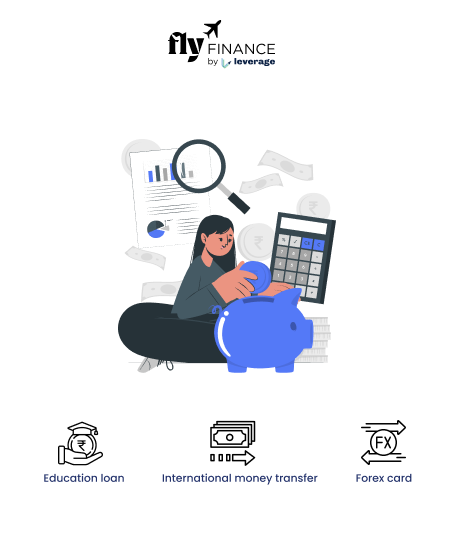Amortisation in Education Loan Refinancing: Education is one of the best ways to achieve your aspirations in terms of studying abroad. However, when you decide to pursue higher education with an education loan it is essential to plan the repayment. While taking the loan make sure that the EMI set by the bank and the date of EMI is suitable for you.
In case you find it challenging to repay the loan later you can easily get an education loan refinancing. In this blog, we will discuss the concept of amortisation in the context of education loans in India and how it plays a pivotal role in your decision for education loan refinancing.
Table of contents
What is Loan Amortisation?
Loan Amortisation is the process of paying off a loan through periodic payments in the form of EMIs. Each EMI amount includes both principal and interest, where the larger amount goes against the interest payment in the initial period of the loan.
When you take an education loan, the EMI is calculated based on several factors like loan amount, interest rate, and the repayment period. Loan amortisation schedules allow you to compare different loan offers by which you can choose the best-suited terms.
Also Read: Floating Interest Rate in Education Loan
Understanding Amortisation Schedules
To understand loan amortisation you need to look at the bigger picture through amortisation schedules. An amortisation schedule is a detailed table that outlines every EMI payment over the loan tenure, breaking down how much goes towards the principal and how much covers the interest.
Through this data, you will be able to understand how much exactly are you paying towards the interest and principal. In this way, you will get complete transparency in your education loan.
- In the initial months, the major amount of your EMI primarily goes toward the interest and a smaller part is allocated to the principal repayment. This is because the outstanding loan balance is higher at the beginning of your loan repayment period.
- As you keep paying regular EMIs through the loan tenure, the principal amount of your EMI gradually increases while the interest portion decreases. This shift is due to the decreasing loan balance.
- In the final stages of your loan repayment, the principal component becomes the major part of your EMI, and the interest is fully paid. Check the example below to understand the amortisation schedule:
| Month | EMI Due (INR) | Interest Paid (INR) | Principal Paid (INR) | Closing Balance (INR) |
| 1 | 2462 | 614 | 1848 | 27805 |
| 2 | 2462 | 614 | 1848 | 25343 |
| 3 | 2462 | 614 | 1848 | 22881 |
| 12 | 3185 | 831 | 2354 | 0 |
The data has been calculated considering the loan amount of INR 25,000 for 12 months with 32% interest rate and INR 885 processing fee. Here, the same EMI amount was paid for up to 12 months. In the last month, an amount of INR 64 was paid as the regular interest and an amount of INR 767 was paid as interest overdue and other charges. This is why the EMI for last month was more than earlier.
How Amortisation Impacts Refinancing Decisions?
Amortisation plays a crucial role in determining whether education loan refinancing is a suitable option for you. It helps you to save the amount which you pay towards the interest on your loan. This will save the overall loan amount and you can also adjust your EMIs subject to terms and conditions. Sounds good but confusing? Let’s understand in detail.
Also Read: Benefits of Education Loan Refinancing
Interest Savings
If you’ve been repaying your education loan for a long time, you’ve likely paid a considerable amount towards the principal. When you get an education loan refinance, the amortisation schedule will be applied freshly and set by the new lender/bank. Depending on the new interest rate and loan tenure, you could potentially save money on interest over the long term.
EMI Adjustments
By education loan refinancing, you may have the option to extend the loan tenure. This will ultimately reduce your monthly EMI. When you get a loan refinance you can negotiate the interest rate, repayment period and other terms and conditions. When the interest rate is lower the cost of the loan will be less thus making the EMI amount lower than the existing one.
Improved Loan Terms
Education Loan Refinancing can also help you secure better loan terms, such as a lower interest rate or more favourable repayment options. You can also get an extended loan for further studies while taking a loan to refinance. Lower interest rates and long repayment periods will make your education loan more affordable and you will be able to manage your finances efficiently.
Note: Please note that while education loan refinancing can offer advantages, it’s not always the best choice for everyone. You should carefully assess the terms and conditions of the new loan, as well as any associated fees, before deciding to refinance.
FAQs
Loan amortisation is the process implemented to lower the value of a loan over some time through a repayment structure. It works through a series of fixed and regular payments which are calculated in such a way that the loan is fully paid off by the end of its term.
If your education loan is amortised then every EMI will be structured in such a way that a fixed amount shall go towards interest as well as principal amount.
A loan amortisation schedule generally helps to calculate the monthly payment break-up of a loan.
Understanding the EMI structure after loan amortisation is important for Indian students dealing with education loans. Amortisation schedules provide a clear picture of how your EMIs are distributed between principal and interest, which in turn can influence your decisions regarding education loan refinancing.
To know more about education loan transfer, the best international bank accounts for students, forex and banking experience for global students or international money transfers, reach out to our experts at 1800572126 to help ease your study abroad experience.
| Related Blogs |
| Documents Required for Unsecured Education Loans |
| Difference between a Loan Sanction Letter and a Loan Disbursement Letter |
| Government Education Loans to Study in Australia |
Follow Us on Social Media





























